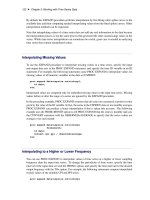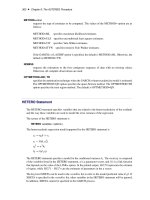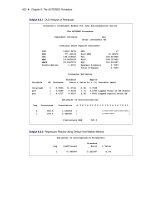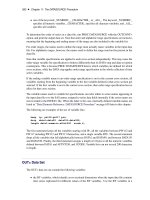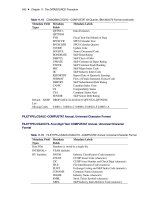SAS/ETS 9.22 User''''s Guide 38 potx
Bạn đang xem bản rút gọn của tài liệu. Xem và tải ngay bản đầy đủ của tài liệu tại đây (272.11 KB, 10 trang )
362 ✦ Chapter 8: The AUTOREG Procedure
METHOD=value
requests the type of estimates to be computed. The values of the METHOD= option are as
follows:
METHOD=ML specifies maximum likelihood estimates.
METHOD=ULS specifies unconditional least squares estimates.
METHOD=YW specifies Yule-Walker estimates.
METHOD=ITYW specifies iterative Yule-Walker estimates.
If the GARCH= or LAGDEP option is specified, the default is METHOD=ML. Otherwise, the
default is METHOD=YW.
NOMISS
requests the estimation to the first contiguous sequence of data with no missing values.
Otherwise, all complete observations are used.
OPTMETHOD=QN | TR
specifies the optimization technique when the GARCH or heteroscedasticity model is estimated.
The OPTMETHOD=QN option specifies the quasi-Newton method. The OPTMETHOD=TR
option specifies the trust region method. The default is OPTMETHOD=QN.
HETERO Statement
The HETERO statement specifies variables that are related to the heteroscedasticity of the residuals
and the way these variables are used to model the error variance of the regression.
The syntax of the HETERO statement is
HETERO variables / options ;
The heteroscedastic regression model supported by the HETERO statement is
y
t
D x
t
ˇ C
t
t
N.0;
2
t
/
2
t
D
2
h
t
h
t
D l.z
0
t
Á/
The HETERO statement specifies a model for the conditional variance
h
t
. The vector
z
t
is composed
of the variables listed in the HETERO statement,
Á
is a parameter vector, and
l./
is a link function
that depends on the value of the LINK= option. In the printed output,
HET 0
represents the estimate
of sigma, while HET 1 - HET n are the estimates of parameters in the Á vector.
The keyword XBETA can be used in the variables list to refer to the model predicted value
x
0
t
ˇ
. If
XBETA is specified in the variables list, other variables in the HETERO statement will be ignored.
In addition, XBETA cannot be specified in the GARCH process.
HETERO Statement ✦ 363
For heteroscedastic regression models without GARCH effects, the errors
t
are assumed to be un-
correlated — the heteroscedasticity models specified by the HETERO statement cannot be combined
with an autoregressive model for the errors. Thus, when a HETERO statement is used, the NLAG=
option cannot be specified unless the GARCH= option is also specified.
You can specify the following options in the HETERO statement.
LINK=value
specifies the functional form of the heteroscedasticity model. By default, LINK=EXP. If you
specify a GARCH model with the HETERO statement, the model is estimated using LINK=
LINEAR only. For details, see the section “Using the HETERO Statement with GARCH
Models” on page 377. Values of the LINK= option are as follows:
EXP
specifies the exponential link function. The following model is estimated
when you specify LINK=EXP:
h
t
D exp.z
0
t
Á/
SQUARE
specifies the square link function. The following model is estimated when
you specify LINK=SQUARE:
h
t
D .1 C z
0
t
Á/
2
LINEAR
specifies the linear function; that is, the HETERO statement variables
predict the error variance linearly. The following model is estimated when
you specify LINK=LINEAR:
h
t
D .1 C z
0
t
Á/
COEF=value
imposes constraints on the estimated parameters
Á
of the heteroscedasticity model. The values
of the COEF= option are as follows:
NONNEG
specifies that the estimated heteroscedasticity parameters
Á
must be non-
negative. When the HETERO statement is used in conjunction with the
GARCH= option, the default is COEF=NONNEG.
UNIT constrains all heteroscedasticity parameters Á to equal 1.
ZERO constrains all heteroscedasticity parameters Á to equal 0.
UNREST
specifies unrestricted estimation of
Á
. When the GARCH= option is not
specified, the default is COEF=UNREST.
STD=value
imposes constraints on the estimated standard deviation
of the heteroscedasticity model. The
values of the STD= option are as follows:
NONNEG
specifies that the estimated standard deviation parameter
must be non-
negative.
364 ✦ Chapter 8: The AUTOREG Procedure
UNIT constrains the standard deviation parameter to equal 1.
UNREST specifies unrestricted estimation of . This is the default.
TEST=LM
produces a Lagrange multiplier test for heteroscedasticity. The null hypothesis is homoscedas-
ticity; the alternative hypothesis is heteroscedasticity of the form specified by the HETERO
statement. The power of the test depends on the variables specified in the HETERO statement.
The test may give different results depending on the functional form specified by the LINK=
option. However, in many cases the test does not depend on the LINK= option. The test is in-
variant to the form of
h
t
when
h
t
.0/ D 1
and
h
0
t
.0/ ¤ 0
. (The condition
h
t
.0/ D 1
is satisfied
except when the NOCONST option is specified with LINK=SQUARE or LINK=LINEAR.)
NOCONST
specifies that the heteroscedasticity model does not include the unit term for the
LINK=SQUARE and LINK=LINEAR options. For example, the following model is
estimated when you specify the options LINK=SQUARE NOCONST:
h
t
D .z
0
t
Á/
2
NLOPTIONS Statement
NLOPTIONS < options > ;
PROC AUTOREG uses the nonlinear optimization (NLO) subsystem to perform nonlinear optimiza-
tion tasks. For a list of all the options of the NLOPTIONS statement, see Chapter 6, “Nonlinear
Optimization Methods.”
RESTRICT Statement
The RESTRICT statement provides constrained estimation. The syntax of the RESTRICT statement
is
RESTRICT equation , . . . , equation ;
The RESTRICT statement places restrictions on the parameter estimates for covariates in the
preceding MODEL statement. The AR, GARCH, and HETERO parameters are also supported in
the RESTRICT statement. Any number of RESTRICT statements can follow a MODEL statement.
Several restrictions can be specified in a single RESTRICT statement by separating the individual
restrictions with commas.
Each restriction is written as a linear equation composed of constants and parameter names. Refer
to model parameters by the name of the corresponding regressor variable. Each name used in the
equation must be a regressor in the preceding MODEL statement. Use the keyword INTERCEPT to
TEST Statement ✦ 365
refer to the intercept parameter in the model. See the section “OUTEST= Data Set” on page 410 for
the names of these parameters.
The following is an example of a RESTRICT statement:
model y = a b c d;
restrict a+b=0, 2
*
d-c=0;
When restricting a linear combination of parameters to be 0, you can omit the equal sign. For
example, the following RESTRICT statement is equivalent to the preceding example:
restrict a+b, 2
*
d-c;
The following RESTRICT statement constrains the parameters estimates for three regressors (X1,
X2, and X3) to be equal:
restrict x1 = x2, x2 = x3;
The preceding restriction can be abbreviated as follows:
restrict x1 = x2 = x3;
The following example shows how to specify AR, GARCH, and HETERO parameters in the
RESTRICT statement:
model y = a b / nlag=2 garch=(p=2,q=3,mean=sqrt);
hetero c d;
restrict _A_1=0,_AH_2=0.2,_HET_2=1,_DELTA_=0.1;
Only simple linear combinations of parameters can be specified in RESTRICT statement expressions;
complex expressions that involve parentheses, division, functions, or complex products are not
allowed.
TEST Statement
The AUTOREG procedure supports a TEST statement for linear hypothesis tests. The syntax of the
TEST statement is
TEST equation , . . . , equation / option ;
The TEST statement tests hypotheses about the covariates in the model that are estimated by the
preceding MODEL statement. The AR, GARCH, and HETERO parameters are also supported in the
TEST statement. Each equation specifies a linear hypothesis to be tested. If more than one equation
is specified, the equations are separated by commas.
Each test is written as a linear equation composed of constants and parameter names. Refer to
parameters by the name of the corresponding regressor variable. Each name used in the equation
must be a regressor in the preceding MODEL statement. Use the keyword INTERCEPT to refer to
the intercept parameter in the model. See the section “OUTEST= Data Set” on page 410 for the
names of these parameters.
366 ✦ Chapter 8: The AUTOREG Procedure
You can specify the following options in the TEST statement:
TYPE=value
specifies the test statistics to use. The default is TYPE=F. The following values for TYPE=
option are available:
F
produces an F test. This option is supported for all models specified in
MODEL statement.
WALD
produces a Wald test. This option is supported for all models specified in
MODEL statement.
LM
produces a Lagrange multiplier test. This option is supported only when
the GARCH= option is specified (for example, when there is a statement
like MODEL Y = C D I / GARCH=(Q=2)).
LR
produces a likelihood ratio test. This option is supported only when the
GARCH= option is specified (for example, when there is a statement like
MODEL Y = C D I / GARCH=(Q=2)).
ALL
produces all tests applicable for a particular model. For non-GARCH-type
models, only F and Wald tests are output. For all other models, all four
tests (LR, LM, F, and Wald) are computed.
The following example of a TEST statement tests the hypothesis that the coefficients of two regressors
A and B are equal:
model y = a b c d;
test a = b;
To test separate null hypotheses, use separate TEST statements. To test a joint hypothesis, specify
the component hypotheses on the same TEST statement, separated by commas.
For example, consider the following linear model:
y
t
D ˇ
0
C ˇ
1
x1
t
C ˇ
2
x2
t
C
t
The following statements test the two hypotheses H
0
W ˇ
0
D 1 and H
0
W ˇ
1
C ˇ
2
D 0:
model y = x1 x2;
test intercept = 1;
test x1 + x2 = 0;
The following statements test the joint hypothesis H
0
W ˇ
0
D 1 and ˇ
1
C ˇ
2
D 0:
model y = x1 x2;
test intercept = 1, x1 + x2 = 0;
To illustrate the TYPE= option, consider the following examples.
model Y = C D I / garch=(q=2);
test C + D = 1;
The proceding statements produce only one default test, the F test.
OUTPUT Statement ✦ 367
model Y = C D I / garch=(q=2);
test C + D = 1 / type = LR;
The proceding statements produce one of four tests applicable for GARCH-type models, the likeli-
hood ratio test.
model Y = C D I / nlag = 2;
test C + D = 1 / type = LM;
The proceding statements produce the warning and do not output any test because the Lagrange
multiplier test is not applicable for non-GARCH models.
model Y = C D I / nlag=2;
test C + D = 1 / type = ALL;
The proceding statements produce all tests that are applicable for non-GARCH models (namely, the
F and Wald tests). The TYPE= prefix is optional. Thus the test statement in the previous example
could also have been written as:
test C + D = 1 / ALL;
The following example shows how to test AR, GARCH, and HETERO parameters:
model y = a b / nlag=2 garch=(p=2,q=3,mean=sqrt);
hetero c d;
test _A_1=0,_AH_2=0.2,_HET_2=1,_DELTA_=0.1;
OUTPUT Statement
OUTPUT OUT=SAS-data-set keyword = options . . . ; ;
The OUTPUT statement creates an output SAS data set as specified by the following options.
OUT=SAS-data-set
names the output SAS data set containing the predicted and transformed values. If the OUT=
option is not specified, the new data set is named according to the DATAn convention.
ALPHACLI=number
sets the confidence limit size for the estimates of future values of the response time series. The
ALPHACLI= value must be between 0 and 1. The resulting confidence interval has 1-number
confidence. The default is ALPHACLI=.05, corresponding to a 95% confidence interval.
ALPHACLM=number
sets the confidence limit size for the estimates of the structural or regression part of the model.
The ALPHACLI= value must be between 0 and 1. The resulting confidence interval has
1-number confidence. The default is ALPHACLM=.05, corresponding to a 95% confidence
interval.
368 ✦ Chapter 8: The AUTOREG Procedure
ALPHACSM=.01 | .05 | .10
specifies the significance level for the upper and lower bounds of the CUSUM and CUSUMSQ
statistics output by the CUSUMLB=, CUSUMUB=, CUSUMSQLB=, and CUSUMSQUB=
options. The significance level specified by the ALPHACSM= option can be .01, .05, or .10.
Other values are not supported.
The following options are of the form KEYWORD=name, where KEYWORD specifies the
statistic to include in the output data set and name gives the name of the variable in the OUT=
data set containing the statistic.
BLUS=variable
specifies the name of a variable to contain the values of the Theil’s BLUS residuals. Refer to
Theil (1971) for more information on BLUS residuals.
CEV=variable
HT=variable
writes to the output data set the value of the error variance
2
t
from the heteroscedasticity
model specified by the HETERO statement or the value of the conditional error variance
h
t
by
the GARCH= option in the MODEL statement.
CPEV=variable
writes the conditional prediction error variance to the output data set. The value of conditional
prediction error variance is equal to that of the conditional error variance when there are no
autoregressive parameters. For the exponential GARCH model, conditional prediction error
variance cannot be calculated. See the section “Predicted Values” on page 405 later in this
chapter for details.
CONSTANT=variable
writes the transformed intercept to the output data set. The details of the transformation are
described in “Computational Methods” on page 372 later in this chapter.
CUSUM=variable
specifies the name of a variable to contain the CUSUM statistics.
CUSUMSQ=variable
specifies the name of a variable to contain the CUSUMSQ statistics.
CUSUMUB=variable
specifies the name of a variable to contain the upper confidence bound for the CUSUM statistic.
CUSUMLB=variable
specifies the name of a variable to contain the lower confidence bound for the CUSUM statistic.
CUSUMSQUB=variable
specifies the name of a variable to contain the upper confidence bound for the CUSUMSQ
statistic.
CUSUMSQLB=variable
specifies the name of a variable to contain the lower confidence bound for the CUSUMSQ
statistic.
OUTPUT Statement ✦ 369
LCL=name
writes the lower confidence limit for the predicted value (specified in the PREDICTED=
option) to the output data set. The size of the confidence interval is set by the ALPHACLI=
option. See the section “Predicted Values” on page 405 later in this chapter for details.
LCLM=name
writes the lower confidence limit for the structural predicted value (specified in the PREDICT-
EDM= option) to the output data set under the name given. The size of the confidence interval
is set by the ALPHACLM= option.
PREDICTED=name
P=name
writes the predicted values to the output data set. These values are formed from both the
structural and autoregressive parts of the model. See the section “Predicted Values” on page 405
later in this chapter for details.
PREDICTEDM=name
PM=name
writes the structural predicted values to the output data set. These values are formed from only
the structural part of the model. See the section “Predicted Values” on page 405 later in this
chapter for details.
RECPEV=variable
specifies the name of a variable to contain the part of the predictive error variance (v
t
) that is
used to compute the recursive residuals.
RECRES=variable
specifies the name of a variable to contain recursive residuals. The recursive residuals are used
to compute the CUSUM and CUSUMSQ statistics.
RESIDUAL=name
R=name
writes the residuals from the predicted values based on both the structural and time series parts
of the model to the output data set.
RESIDUALM=name
RM=name
writes the residuals from the structural prediction to the output data set.
TRANSFORM=variables
transforms the specified variables from the input data set by the autoregressive model and
writes the transformed variables to the output data set. The details of the transformation
are described in “Computational Methods” on page 372 later in this chapter. If you need to
reproduce the data suitable for reestimation, you must also transform an intercept variable. To
do this, transform a variable that is all 1s or use the CONSTANT= option.
UCL=name
writes the upper confidence limit for the predicted value (specified in the PREDICTED=
option) to the output data set. The size of the confidence interval is set by the ALPHACLI=
option. See the section “Predicted Values” on page 405 later in this chapter for details.
370 ✦ Chapter 8: The AUTOREG Procedure
UCLM=name
writes the upper confidence limit for the structural predicted value (specified in the PRE-
DICTEDM= option) to the output data set. The size of the confidence interval is set by the
ALPHACLM= option.
Details: AUTOREG Procedure
Missing Values
PROC AUTOREG skips any missing values at the beginning of the data set. If the NOMISS option
is specified, the first contiguous set of data with no missing values is used; otherwise, all data with
nonmissing values for the independent and dependent variables are used. Note, however, that the
observations containing missing values are still needed to maintain the correct spacing in the time
series. PROC AUTOREG can generate predicted values when the dependent variable is missing.
Autoregressive Error Model
The regression model with autocorrelated disturbances is as follows:
y
t
D x
0
t
ˇ C
t
t
D
t
'
1
t1
: : : '
m
tm
t
N.0;
2
/
In these equations,
y
t
are the dependent values,
x
t
is a column vector of regressor variables,
ˇ
is
a column vector of structural parameters, and
t
is normally and independently distributed with a
mean of 0 and a variance of
2
. Note that in this parameterization, the signs of the autoregressive
parameters are reversed from the parameterization documented in most of the literature.
PROC AUTOREG offers four estimation methods for the autoregressive error model. The default
method, Yule-Walker (YW) estimation, is the fastest computationally. The Yule-Walker method used
by PROC AUTOREG is described in Gallant and Goebel (1976). Harvey (1981) calls this method
the two-step full transform method. The other methods are iterated YW, unconditional least squares
(ULS), and maximum likelihood (ML). The ULS method is also referred to as nonlinear least squares
(NLS) or exact least squares (ELS).
You can use all of the methods with data containing missing values, but you should use ML estimation
if the missing values are plentiful. See the section “Alternative Autocorrelation Correction Methods”
on page 374 later in this chapter for further discussion of the advantages of different methods.
Autoregressive Error Model ✦ 371
The Yule-Walker Method
Let ' represent the vector of autoregressive parameters,
' D .'
1
; '
2
; : : :; '
m
/
0
and let the variance matrix of the error vector D .
1
; : : :;
N
/
0
be †,
E.
0
/ D † D
2
V
If the vector of autoregressive parameters
'
is known, the matrix
V
can be computed from the
autoregressive parameters.
†
is then
2
V
. Given
†
, the efficient estimates of regression parameters
ˇ
can be computed using generalized least squares (GLS). The GLS estimates then yield the unbiased
estimate of the variance
2
,
The Yule-Walker method alternates estimation of
ˇ
using generalized least squares with estimation of
'
using the Yule-Walker equations applied to the sample autocorrelation function. The YW method
starts by forming the OLS estimate of
ˇ
. Next,
'
is estimated from the sample autocorrelation
function of the OLS residuals by using the Yule-Walker equations. Then
V
is estimated from the
estimate of
'
, and
†
is estimated from
V
and the OLS estimate of
2
. The autocorrelation corrected
estimates of the regression parameters
ˇ
are then computed by GLS, using the estimated
†
matrix.
These are the Yule-Walker estimates.
If the ITER option is specified, the Yule-Walker residuals are used to form a new sample autocorrela-
tion function, the new autocorrelation function is used to form a new estimate of
'
and
V
, and the
GLS estimates are recomputed using the new variance matrix. This alternation of estimates continues
until either the maximum change in the
b'
estimate between iterations is less than the value specified
by the CONVERGE= option or the maximum number of allowed iterations is reached. This produces
the iterated Yule-Walker estimates. Iteration of the estimates may not yield much improvement.
The Yule-Walker equations, solved to obtain b' and a preliminary estimate of
2
, are
R O' D r
Here
r D .r
1
; : : :; r
m
/
0
, where
r
i
is the lag i sample autocorrelation. The matrix
R
is the Toeplitz
matrix whose i,jth element is
r
jij j
. If you specify a subset model, then only the rows and columns
of R and r corresponding to the subset of lags specified are used.
If the BACKSTEP option is specified, for purposes of significance testing, the matrix
ŒR r
is
treated as a sum-of-squares-and-crossproducts matrix arising from a simple regression with
N k
observations, where k is the number of estimated parameters.
The Unconditional Least Squares and Maximum Likelihood Methods
Define the transformed error, e, as
e D L
1
n
where n D y Xˇ.

